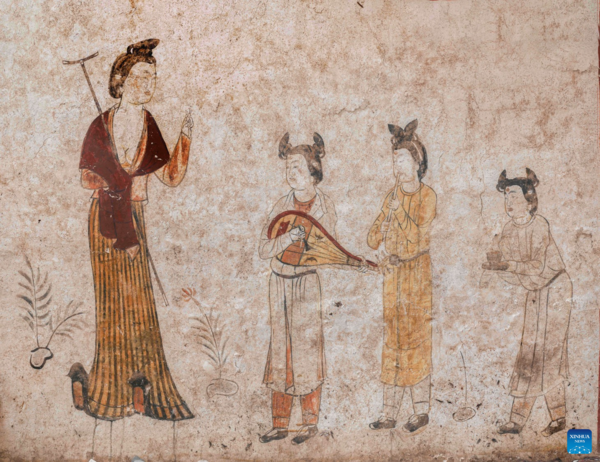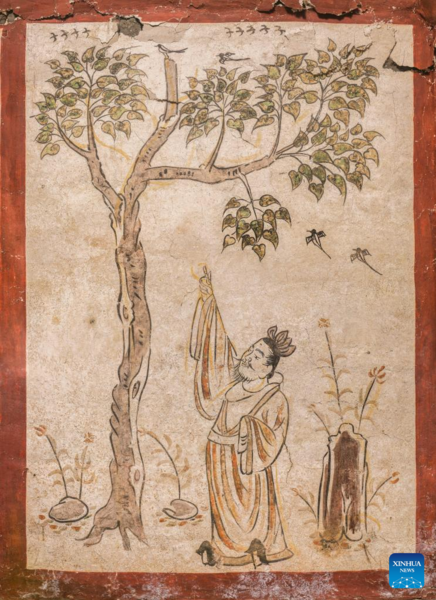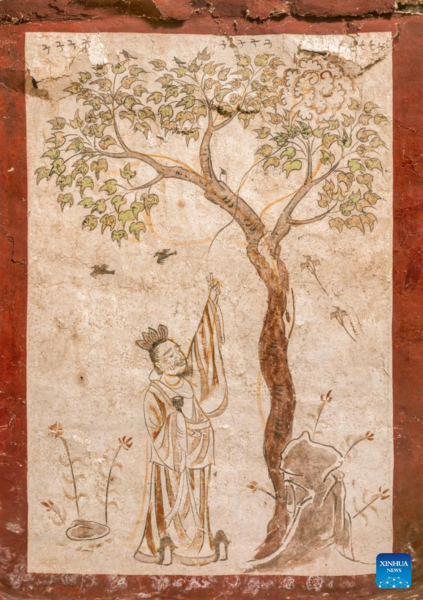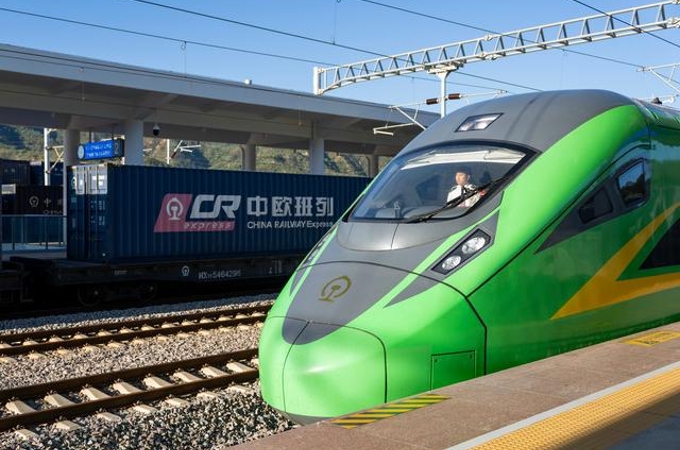Millennium-old tomb restored in China's Shanxi
Source: Xinhua | 2021-12-29 | Editor:Lexi

Undated file photo provided by Taiyuan Institute of Cultural Relics Protection shows a part of restored murals of an ancient tomb dating back to the Tang Dynasty (618-907) in Taiyuan, north China's Shanxi Province. The tomb was discovered in an elementary school in Taiyuan, capital of Shanxi, in 2019 and later moved to the museum for protection and restoration.
Defects in the murals such as fissures, hollows and blemishes have been fixed, and the tomb will open to the public in the future, said the Taiyuan Northern Qi Dynasty Mural Museum.
Interestingly, various figures in the mural paintings appear to be making "V" signs with their middle and index fingers. (Taiyuan Institute of Cultural Relics Protection/Handout via Xinhua)
An ancient tomb with rare murals dating back to the Tang Dynasty (618-907) has been restored in north China's Shanxi Province, according to the Taiyuan Northern Qi Dynasty Mural Museum.
The tomb was discovered in an elementary school in Taiyuan, capital of Shanxi, in 2019 and later moved to the museum for protection and restoration.
According to the epitaph, the tomb owner Guo Xing was a mid-ranking military officer in the Tang Dynasty. The roof, walls, coffin bed, corridors and the doors of the tomb were all decorated with exquisite murals.
Defects in the murals such as fissures, hollows and blemishes have been fixed, and the tomb will open to the public in the future, said the museum.
Interestingly, various figures in the mural paintings appear to be making "V" signs with their middle and index fingers.
The exquisite murals of the tomb reveal the noble status of the tomb owner and attest to its historical, artistic and scientific value, said Feng Gang, a researcher at the Taiyuan Institute of Cultural Relics Protection.

Undated file photo provided by Taiyuan Institute of Cultural Relics Protection shows a part of restored murals of an ancient tomb dating back to the Tang Dynasty (618-907) in Taiyuan, north China's Shanxi Province. The tomb was discovered in an elementary school in Taiyuan, capital of Shanxi, in 2019 and later moved to the museum for protection and restoration.Defects in the murals such as fissures, hollows and blemishes have been fixed, and the tomb will open to the public in the future, said the Taiyuan Northern Qi Dynasty Mural Museum.Interestingly, various figures in the mural paintings appear to be making "V" signs with their middle and index fingers. (Taiyuan Institute of Cultural Relics Protection/Handout via Xinhua)

Undated file photo provided by Taiyuan Institute of Cultural Relics Protection shows a part of restored murals of an ancient tomb dating back to the Tang Dynasty (618-907) in Taiyuan, north China's Shanxi Province. The tomb was discovered in an elementary school in Taiyuan, capital of Shanxi, in 2019 and later moved to the museum for protection and restoration.Defects in the murals such as fissures, hollows and blemishes have been fixed, and the tomb will open to the public in the future, said the Taiyuan Northern Qi Dynasty Mural Museum.Interestingly, various figures in the mural paintings appear to be making "V" signs with their middle and index fingers. (Taiyuan Institute of Cultural Relics Protection/Handout via Xinhua)
You May Like
-
Yearender-World Insights: Belt and Road rail services, const...
Though the world remains haunted by the still ravaging COVID-19 pandemic in the year 2021, the China-proposed Belt and Road Initiative (BRI) has seen a boom in ...
InKunming 2021-12-27 -
How the Belt and Road is quietly improving livelihoods in Eu...
It may not be unusual for people in Europe to come across the idea of the Belt and Road Initiative (BRI) on news media, but it is highly likely that few have a ...
InKunming 2021-12-27 -
China-Laos Railway sees growth in freight transport
The China-Laos Railway has transported over 50,000 tonnes of goods since starting operation earlier this month, according to the China Railway Kunming Group Co....
InKunming 2021-12-27 -
Interview: Joint construction of BRI to promote common devel...
The joint construction of the Belt and Road Initiative (BRI), a development-driven path aiming for mutual benefit, will promote the common development of all co...
InKunming 2021-12-27 -
Yearender: Belt and Road projects yield fruits, forge ahead ...
In early December, landlocked Laos took a quantum leap toward the nation's dream of becoming a land-linked hub thanks to the inauguration of the China-Laos Rail...
InKunming 2021-12-27 -
CPEC's 2nd phase to expedite socio-economic development of P...
The second phase of the China-Pakistan Economic Corridor (CPEC) will accelerate the socio-economic development in Pakistan, Khalid Mansoor, special assistant to...
InKunming 2021-12-27 -
Jiangsu reports rise of China-Europe freight train trips in ...
China's Jiangsu Province handled more than 1,600 China-Europe freight train trips in the first 11 months of the year, up 32.76 percent year on year, Nanjing Cus...
InKunming 2021-12-27 -
China-Europe freight train trips rise in Jan.-Nov.
China-Europe freight train trips saw a steady increase in the first 11 months of the year, data from the top economic planner showed.
InKunming 2021-12-27 -
Interview: BRI fosters multilateralism and inclusive growth,...
The China-proposed Belt and Road Initiative (BRI) has created a platform for promoting multilateralism, inclusive growth, peace and cohesion, Erastus Mwencha, f...
InKunming 2021-12-27 -
North China ports bustle with China-Europe freight trains
China's land ports of Manzhouli and Suifenhe on the China-Russia border have seen over 4,500 China-Europe freight trains this year, according to the China Railw...
InKunming 2021-12-27







